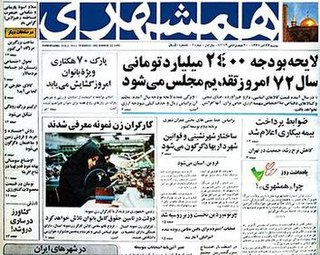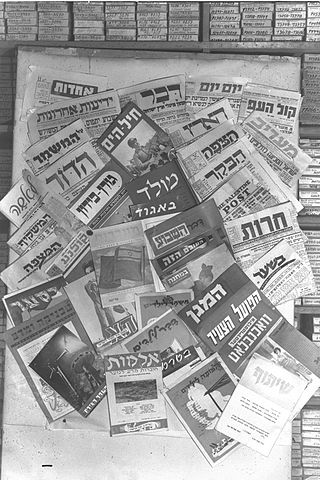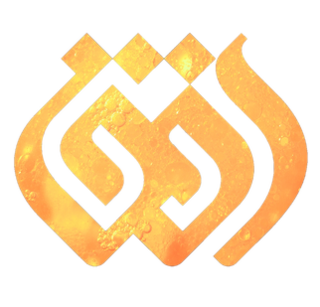
Al Arabiya is a Saudi state-owned international Arabic news television channel. It is based in Riyadh and is a subsidiary of MBC Group.

The Islamic Republic of Iran Broadcasting formerly called National Iranian Radio and Television until the Iranian revolution of 1979, is an Iranian state-controlled media corporation that holds a monopoly of domestic radio and television services in Iran. It is also among the largest media organizations in Asia and the Pacific region and a regular member of the Asia-Pacific Broadcasting Union. Its head is appointed directly by the Supreme Leader, Ayatollah Ali Khamenei.

Hamshahri is a major national Iranian Persian-language newspaper.
In Iran, censorship was ranked among the world's most extreme in 2023. Reporters Without Borders ranked Iran 177 out of 180 countries in the World Press Freedom Index, which ranks countries from 1 to 180 based on the level of freedom of the press. Reporters Without Borders described Iran as “one of the world’s five biggest prisons for media personnel" in the 40 years since the revolution. In the Freedom House Index, Iran scored low on political rights and civil liberties and has been classified as 'not free.'

Al-Alam is an Arabic news channel broadcasting from Iran and owned by the state-owned media corporation Islamic Republic of Iran Broadcasting (IRIB).

Radio Zamaneh is an Amsterdam-based Persian language exile news platform and former radio broadcaster with a leftist approach. "Zamaneh" is the Persian literary term for "time".
The mass media in Singapore refers to mass communication methods through broadcasting, publishing, and the Internet available in the city-state. Singapore's media environment is a duopoly - it is dominated by two major players, Mediacorp and SPH Media.

There are over ten different languages in the Israeli media, with Hebrew as the predominant one. Press in Arabic caters to the Arab citizens of Israel, with readers from areas including those governed by the Palestinian National Authority. During the eighties and nineties, the Israeli press underwent a process of significant change as the media gradually came to be controlled by a limited number of organizations, whereas the papers published by political parties began to disappear. Today, three large, privately owned conglomerates based in Tel Aviv dominate the mass media in Israel.

Press TV is an Iranian state-owned news network that broadcasts in the English and French languages owned by Islamic Republic of Iran Broadcasting (IRIB), the only organization legally able to transmit radio and TV broadcasts in Iran. The 24-hour channel, which has headquarters in Tehran, was launched on 2 July 2007 and was intended to compete with western English language services.

The Ministry of Culture and Islamic Guidance is the Ministry of Culture of the Islamic Republic of Iran. It is responsible for managing access to media that, in the view of the Iranian government or the ministry, violates Iranian ethics or promotes values alien to Iranian culture. This may include internet censorship. It also manages the alignment of religion and the law of the country. It was formed by combining the Ministry of Culture and Art, and the Ministry of Information and Tourism. The merging of Ministries reduces the number of employment positions as the number of employable ministries also lessens.
The mass media in Afghanistan is monitored by the Ministry of Information and Culture (MoIC), and includes broadcasting, digital and printing. It is mainly in Dari and Pashto, the official languages of the nation. It was reported in 2019 that Afghanistan had over 107 TV stations and 284 radio stations, including 100s of print media and over 1,800 online media outlets. After the return of the Islamic Emirate of Afghanistan (IEA) in 2021, there was a concern that the mass media will significantly decrease in the country. The number of digital media outlets is steadily increasing with the help of Facebook, Instagram, TikTok, Twitter, YouTube, and other such online platforms. IEA's spokesman Zabihullah Mujahid suggested that the media should be in line with Sharia and national interests.

Algeria has more than 45 independent Arabic language and French language publications as well as 4 government-owned newspapers, but the government controls most printing presses and advertising. The Algerian newspapers with the largest circulations are Echourouk (1,800,000), Ennahar (1,600,000), El Khabar (1,000,000) and Quotidien d'Oran (700,000); all four are employee-owned. In 2004 and 2005, the government increased the access of Berber language and culture to both print and broadcast media.
Jam-e Jam is a Persian language daily newspaper published in Iran.

BBC Persian Television is the BBC's Persian language news channel that was launched on 14 January 2009. The service is broadcast by satellite and is also available online. It is aimed at the 120 million Persian-speakers in Iran, Afghanistan, Tajikistan, and Uzbekistan.
Public diplomacy in the Islamic Republic of Iran refers to the public relations efforts to disseminate information about the Islamic Republic of Iran. Such efforts seek to communicate with foreign publics in order to establish a dialogue designed to inform and influence. Instruments of public diplomacy in the Islamic Republic of Iran include cultural exchanges, film and print media, and sports diplomacy.
Television was first introduced to Iran in 1958, as a privately-owned and commercially-operated enterprise, before being nationalised, remaining a state-controlled monopoly, first of National Iranian Radio and Television, and following the Iranian Revolution in 1979, of Islamic Republic of Iran Broadcasting.
Financial Tribune was a non-governmental newspaper in Iran opened in 2014. Its purpose is to cover a variety of political, economic, technology, and social stories. Though it covers a wide gamut of issues, the main focus of the newspaper is on commerce, in particular news/views related to promoting private enterprise in the economy.

IRIB Ofogh, is an Islamic Republic of Iran Broadcasting television channel, is broadcast Worldwide.

Iran International is a Persian language news television channel headquartered in London aimed at Iranian viewers, and broadcasting free-to-air by satellite. Iran International was established in May 2017 in London and has broadcast its programmes from both London and Washington, D.C. In February 2023, Iran International moved its headquarters temporarily to Washington, D.C. due to increased threats from the Iranian government against Iran International's UK-based journalists, but back to London in September 2023. It is available online, via radio and via satellite broadcasting worldwide including Iran.












